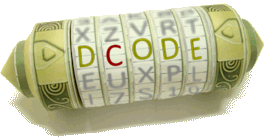Tool to convert numbers into Egyptian hieroglyphic notation/numerals, convert Egyptian numbers to Arabic numbers and Arabic numbers to Egyptian numbers.
Egyptian Numerals - dCode
Tag(s) : Numeral System, History, Symbol Substitution
dCode is free and its tools are a valuable help in games, maths, geocaching, puzzles and problems to solve every day!
A suggestion ? a feedback ? a bug ? an idea ? Write to dCode!
Egyptian Numerals
Convert Arabic to Egyptian Numbers
Convert Egyptian to Hindu-Arabic Numbers
Answers to Questions (FAQ)
What are Egyptian numerals? (Definition)
Egyptian Numerals is a numbering system based on the use of symbols to represent numbers.
Unlike our Arabic numeral system, the Egyptians primarily used symbols related to powers of 10.
How to write a number with Egyptian numerals?
The Egyptian numeral system was additive (position does not matter) and decimal (base 10).
To write a number, the Egyptians had available 7 signs / digits all having a value of a power of 10 which had to be repeated as many times as necessary:
| 𓏺 | 1 |
|---|---|
| 𓎆 | 10 |
| 𓍢 | 100 |
| 𓆼 | 1000 |
| 𓂭 | 10000 |
| 𓆐 | 100000 |
| 𓁨 | 1000000 |
Use the form at the top of this page to convert an Egyptian number.
Example: 123 is written 𓍢𓎆𓎆𓏺𓏺𓏺
The number zero does not exist in this system, the absence of a symbol indicates that there is 0.
Example: 2001 is written 𓆼𓆼𓏺
The Egyptians sometimes used fractions (vertically), the symbol of which is 𓂋
Example: 1/3 is written
𓂋
𓏺𓏺𓏺
(NB: no 1 in the numerator)
How to convert an Egyptian number into Arabic numerals?
Identify each Egyptian symbol and add their values in Hindu-Arabic numerals, the sum obtained is the result of the conversion.
Example: 𓍢𓍢𓏺𓏺𓏺 sis written with 2 times 𓍢 that is the symbol for the value 100 and 3 times 𓏺 that is the symbol for the value 1. Therefore the sum is $ 2 \times 100 + 3 \times 1 = 203 $
How to recognize a Egyptian numbers?
In Egypt, the symbols of the figures are hieroglyphics representing:
| 𓏺 | 1 | stroke/bar/stick |
| 𓎆 | 10 | hobble/yoke/bridge |
| 𓍢 | 100 | rope/spiral |
| 𓆼 | 1000 | water-lily/lotus |
| 𓂭 | 10000 | finger |
| 𓆐 | 100000 | tadpole |
| 𓁨 | 1000000 | Heh/God |
| 𓂋 | / | mouth |
Egyptian Numeral symbols can be used in tattoos for their aesthetic, dates of birth are not necessarily the best choice.
References to Egypt such as the pyramids or the pharaohs are clues.
How to write a date with Egyptian numbers?
The management of the dates of the Egyptian calendar was based on the fluctuations of the Nile and the harvests (therefore nothing reliable or reproducible). Writing a date of birth in Egyptian numbers is an anachronism.
However, it is possible to write a date by separating the 3 numbers of the day, month and year.
Source code
dCode retains ownership of the "Egyptian Numerals" source code. Any algorithm for the "Egyptian Numerals" algorithm, applet or snippet or script (converter, solver, encryption / decryption, encoding / decoding, ciphering / deciphering, breaker, translator), or any "Egyptian Numerals" functions (calculate, convert, solve, decrypt / encrypt, decipher / cipher, decode / encode, translate) written in any informatic language (Python, Java, PHP, C#, Javascript, Matlab, etc.) or any database download or API access for "Egyptian Numerals" or any other element are not public (except explicit open source licence). Same with the download for offline use on PC, mobile, tablet, iPhone or Android app.
Reminder: dCode is an educational and teaching resource, accessible online for free and for everyone.
Cite dCode
The content of the page "Egyptian Numerals" and its results may be freely copied and reused, including for commercial purposes, provided that dCode.fr is cited as the source (Creative Commons CC-BY free distribution license).
Exporting the results is free and can be done simply by clicking on the export icons ⤓ (.csv or .txt format) or ⧉ (copy and paste).
To cite dCode.fr on another website, use the link:
In a scientific article or book, the recommended bibliographic citation is: Egyptian Numerals on dCode.fr [online website], retrieved on 2025-11-07,

.png)
.png)
.png)